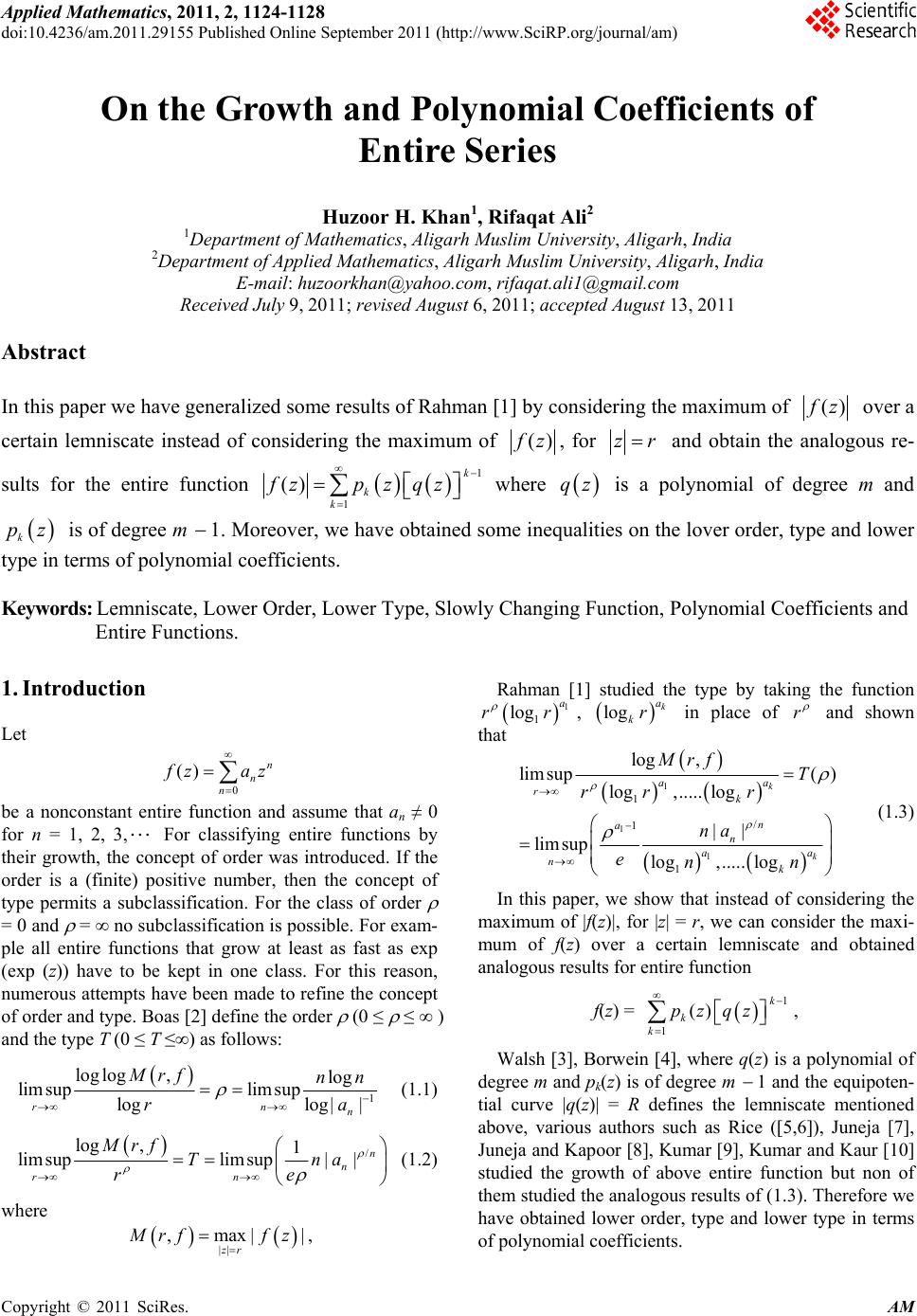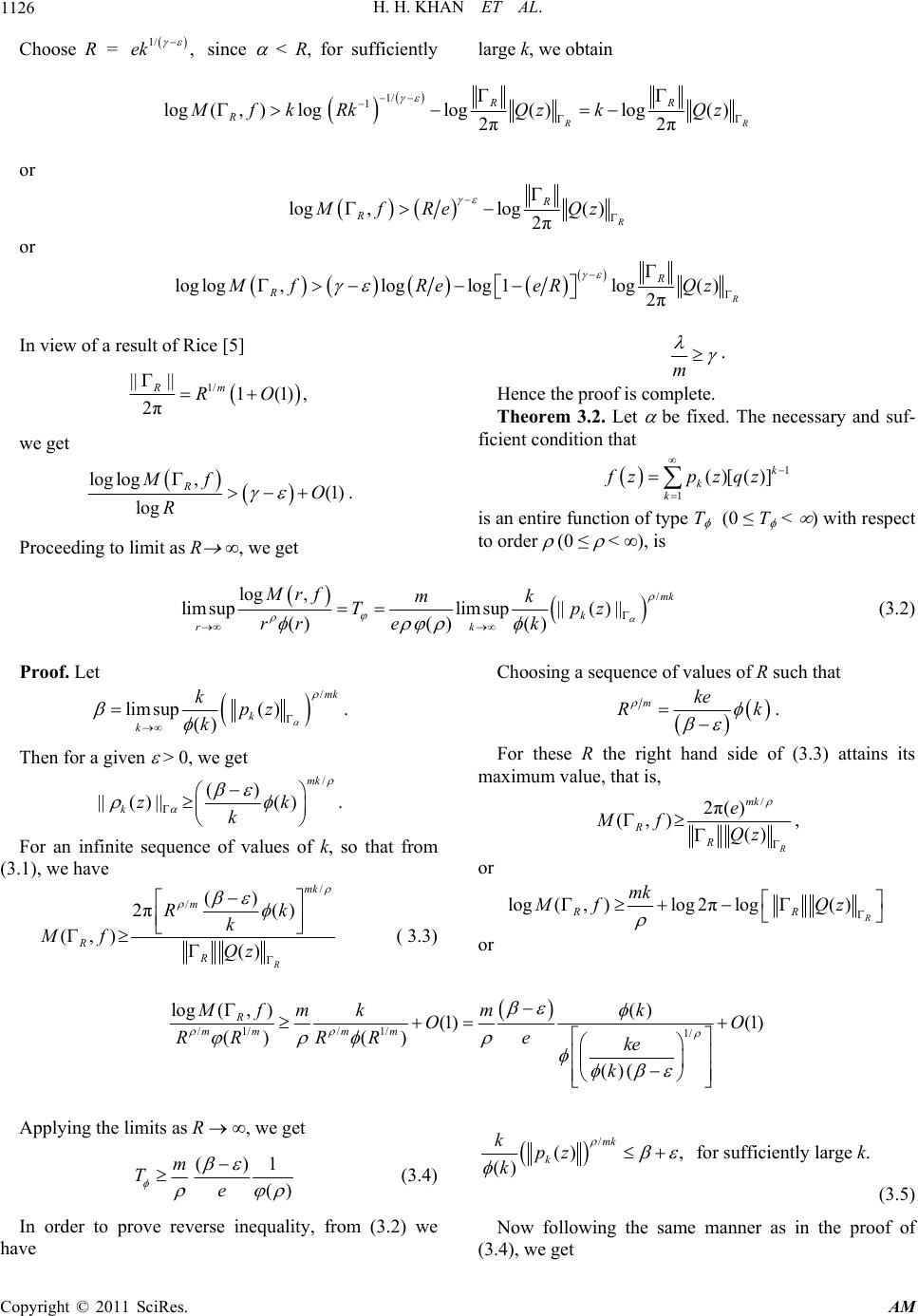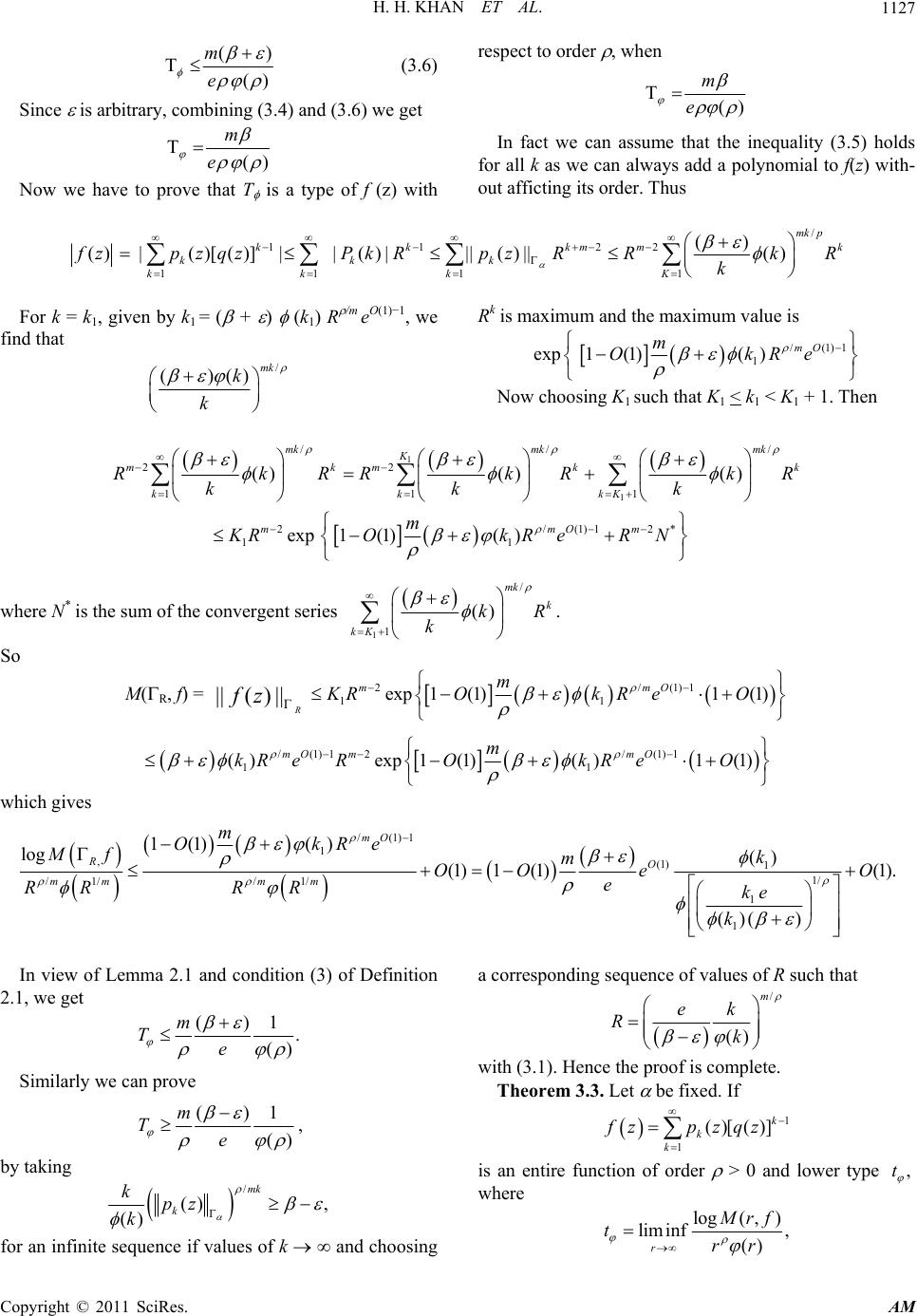 Applied Mathematics, 2011, 2, 1124-1128 doi:10.4236/am.2011.29155 Published Online September 2011 (http://www.SciRP.org/journal/am) Copyright © 2011 SciRes. AM On the Growth and Polynomial Coefficients of Entire Series Huzoor H. Khan1, Rifaqat Ali2 1Department of Mathematics, Aligarh Muslim University, Aligarh, India 2Department of Applied Mathematics, Aligarh Muslim University, Aligarh, India E-mail: huzoorkhan@yahoo.com, rifaqat.ali1@gmail.com Received July 9, 2011; revised August 6, 2011; accepted August 13, 2011 Abstract In this paper we have generalized some results of Rahman [1] by considering the maximum of () z over a certain lemniscate instead of considering the maximum of () z, for zr and obtain the analogous re- sults for the entire function 1 1 () k k k fzp zqz where qz is a polynomial of degree m and k z is of degree m 1. Moreover, we have obtained some inequalities on the lover order, type and lower type in terms of polynomial coefficients. Keywords: Lemniscate, Lower Order, Lower Type, Slowly Changing Function, Polynomial Coefficients and Entire Functions. 1. Introduction Let 0 () n n n za z be a nonconstant entire function and assume that an ≠ 0 for n = 1, 2, 3, For classifying entire functions by their growth, the concept of order was introduced. If the order is a (finite) positive number, then the concept of type permits a subclassification. For the class of order = 0 and = no subclassification is possible. For exam- ple all entire functions that grow at least as fast as exp (exp (z)) have to be kept in one class. For this reason, numerous attempts have been made to refine the concept of order and type. Boas [2] define the order (0 ≤ ≤ ) and the type T (0 ≤ T ≤) as follows: 1 log log,log lim suplim sup log log| | rn n Mrfnn ra (1.1) / log ,1 lim suplim sup||n n rn MrfTna e r | (1.2) where || ,max| zr rff z , Rahman [1] studied the type by taking the function , in place of 1 1 log a rr log k a krr and shown that 1 1 1 1 / 1 1 log , lim sup() log,..... log || lim sup log,..... log k k a a rk n a n a a nk MrfT rr r na enn (1.3) In this paper, we show that instead of considering the maximum of |f(z)|, for |z| = r, we can consider the maxi- mum of f(z) over a certain lemniscate and obtained analogous results for entire function f(z) = , 1 1 () k k k pzqz Walsh [3], Borwein [4], where q(z) is a polynomial of degree m and pk(z) is of degree m 1 and the equipoten- tial curve |q(z)| = R defines the lemniscate mentioned above, various authors such as Rice ([5,6]), Juneja [7], Juneja and Kapoor [8], Kumar [9], Kumar and Kaur [10] studied the growth of above entire function but non of them studied the analogous results of (1.3). Therefore we have obtained lower order, type and lower type in terms of polynomial coefficients.  H. H. KHAN ET AL.1125 Rice [5] has extended the results (1.1) and (1.2) for the lemniscate R.: |q(z)| = R, i.e., 1 log log,log lim sup/lim sup, log log||() || R Rn na Mf nn m Rpz (1.4) / / log , lim suplim sup(), mn R n ma Rn n Mf m Tnpz e R (1.5) where M(R, f) = |()|| max|() RR z zf z , is the boundary of the lemniscate. Analogous to (1.4) the lower order if f(z) can be de- fined as , log log lim inflog R R f mR 2. Definitions and Auxiliary Results Definition 2.1. Slowly changing function (r) is defined as: 1) (r) is positive, continuous and tends to as r, 2) lim 1 r kr r , for every fixed k > 0, 3) 1/ 0 x x x , bounded as . Now we prove Lemma 2.1. 1 1 ()[()] k k k fz pzqz is an entire function of order > 0 and type T with re- spect to order , if and only if, /1/ log , lim sup. R mm R Mf T RR Proof. Set S = R1/m (1+ O(1)), so that from the esti- mate Rice [5], as R for z R, |z| = S, we have 1/ |||| 2π11 m RRO /1/ log,log ,log , lim suplim suplimsup. (1 (1)(1 (1) R mm RSS Mf MSfMSf T SS RR SO SO Lemma 2.2. 1 1 ()[()] k k k fz pzqz is an entire function of order > o and lower type T , if and only if /1/ log , lim inf. R mm R Mf t RR Proof. Proof can be done in a similar manner as Lemma 2.1. 3. Main Results First we prove the inequality for lower order in terms of polynomial coefficients. Theorem 3.1. Let be fixed and 1 1 ()[()] k k k fz pzqz be an entire function of order > 0 and lower order , then, 1 log lim inf log||() || k ka kk m pz . Proof. Let 1 log lim inf, log||() || k ka kk pz so log log||() ||, ka kk pz for k > K( ). Using the relation Rice [5] , |||| () ||()||||() ||, 2πR RR ka k Mf pzQza R R (3.1) have Q(z) is a polynomial of degree m 1, independent of K and R, we get || || 2πlog log(,)log||() ||loglog||()|| ||||||() ||2π R k R Rk R Rkk MfpzkR Qz Qz Copyright © 2011 SciRes. AM  H. H. KHAN ET AL. 1126 Choose R = 1/ ,ek since < R, for sufficiently large k, we obtain 1/ 1 log(,)loglog( )log( ) 2π2π R RR R MfkRkQz kQz or log,log( ) 2π R R MfRe Qz or log log,loglog1log() 2π R R MfRe eRQz In view of a result of Rice [5] 1/ || ||1(1) 2π m RRO , we get log log,(1) log R Mf O R . Proceeding to limit as R , we get m . Hence the proof is complete. Theorem 3.2. Let be fixed. The necessary and suf- ficient condition that 1 1 ()[()] k k k fz pzqz is an entire function of type T (0 ≤ T < ) with respect to order (0 ≤ < ), is / log , lim suplim sup||()|| () () () mk k rk Mrfmk Tp ek rr z (3.2) Proof. Let / lim sup() () mk k k kpz k . Then for a given > 0, we get / () ||() ||() mk kzk k . For an infinite sequence of values of k, so that from (3.1), we have / /() 2π() (,) () R mk m R R Rk k Mf Qz ( 3.3) Choosing a sequence of values of R such that mke Rk . For these R the right hand side of (3.3) attains its maximum value, that is, / 2π() (,) () mk R R e Mf Qz , or log(,)log 2πlog( )R RR mk Mf Qz or /1/ /1/1/ log(, )() (1) (1) () () ()( R mm mm Mf mk mk OO e RR RRke k Applying the limits as R , we get ()1 () m Te (3.4) In order to prove reverse inequality, from (3.2) we have / () , () mk k kpz k for sufficiently large k. (3.5) Now following the same manner as in the proof of (3.4), we get C opyright © 2011 SciRes. AM  H. H. KHAN ET AL.1127 ( () m e ) (3.6) Since is arbitrary, combining (3.4) and (3.6) we get () m e Now we have to prove that T is a type of f (z) with respect to order , when () m e In fact we can assume that the inequality (3.5) holds for all k as we can always add a polynomial to f(z) with- out afficting its order. Thus / 11 22 1111 () ()|()[()]|| ()|||()||() mk p kk kmm kkk kkkK k zpzqzPkR pzRRk k R For k = k1, given by k1 = ( + ) (k1) R /m eO(1)−1, we find that / ()() mk k k Rk is maximum and the maximum value is /(1)1 1 exp1(1)()mO m OkR e Now choosing K1 such that K1 < k1 < K1 + 1. Then 1 1 // 22 111 2/(1)12* 11 ()() () exp1(1)() mkmk mk K mkmk kkkK mmOm R kRR kRkR kkk m KROk ReRN / k where N* is the sum of the convergent series 1 / 1 () mk k kK kR k . So M(R, f) = R zf ||)(|| 2/ 11 exp 1(1)1(1) mm m KROk ReO (1)1O /(1) 12/(1) 1 11 ()exp1 (1)()1 (1) mO mmO m kR eROkR eO which gives /(1)1 1 ,(1) 1 1/ /1//1/ 1 1 1(1) () log () (1) 1(1)(1). ()( ) mO RO mmm m m OkRe Mf k m OO eO e RR RRke k In view of Lemma 2.1 and condition (3) of Definition 2.1, we get ()1 . () m Te Similarly we can prove ()1 () m Te , by taking / () , () mk k kpz k for an infinite sequence if values of k and choosing a corresponding sequence of values of R such that / () m ek Rk with (3.1). Hence the proof is complete. Theorem 3.3. Let be fixed. If 1 1 ()[()] k k k fz pzqz is an entire function of order > 0 and lower type ,t where log( ,) lim inf, () r rf trr Copyright © 2011 SciRes. AM  H. H. KHAN ET AL. 1128 Then / lim inf() () () mk k k mk pz t ek (3.7) Proof. The proof of this theorem follows on the lines of the necessary part of Theorem 3.2, by writing / 'liminf( ) () mk k k kpz k and for a given > 0, / ()( ') mk k kpz k for k > K( ), so that we may choose a sequence of values of R satisfy- ing /. ()( ') mke Rk Now using the relation (3.1) and Lemma 2.2, we get the required result. Hence the proof is complete. Remark 3.1. Theorem 3.2 is the generalization of the result (1.3) by Rahman [1]. Remark 3.2. Rahman’s theorem [1], if 1 1 log , () lim inf(log),....(log) k rk Mrf T krr r then 1 1 1 / 1 () liminf|| (log),....(log)k n n nk n Ta enn is a special case of Theorem 3.3, if we take and consider the circle |z| = r, instead if the lemniscate |q(z)| = R. 1 1 log,... logk a a k rr r 4. References [1] Q. I. Rahman, “On the Coefficients of an Entire Series of Finite Order,” Math Student, Vol. 25, 1957, pp. 113-121. [2] R. P. Boas, “Entire Functions,” Academic Press, New York, 1954, pp. 9-11. [3] J. L. Walsh, “Interpolation and Approximation,” Ameri- can Mathematical Society, Colloquim Publications, Provi- dence, Vol. 20, 1960, p. 56. [4] P. Borwein, “The Arc Length of the Lemniscate {|p(z)| = 1},” Proceedings of the AMS—American Mathematical Society, Vol. 123, 1995, pp. 797-799. [5] J. R. Rice, “A Characterization of Entire Functions in Terms of Degree of Convergence,” Bulletin of the Ameri- can Mathematical Society, Vol. 76, 1970, p. 129. doi:10.1090/S0002-9904-1970-12396-5 [6] J. R. Rice, “The Degree of Convergence for Entire Func- tions,” Duke Mathematical Journal, Vol. 38, No. 3, 1971, pp. 429-440. doi:10.1215/S0012-7094-71-03852-X [7] O. P. Juneja, “On the Coefficients of Entire Series,” Journal of Mathematical Analysis, Vol. 24, 1971, pp. 395-401. [8] O. P. Juneja and G. P. Kapoor, “Polynomial Coefficients of Entire Series,” Yokohama Mathematical Journal, Vol. 22, 1974, pp. 125-133. [9] D. Kumar, “Approximation Error and Generalized Orders of an Entire Function,” Tamsui Oxford Journal of Mathematical Sciences, Vol. 25, No. 2, 2009, pp. 225- 235. [10] D. Kumar and H. Kaur, “Lp—Approximation Error and Generalized Growth Parameters of Analytic Functions in Coratheodory Domains,” International Journal of Mathe- matical Analysis, Vol. 3, No. 30, 2009, pp. 1461-1472. Copyright © 2011 SciRes. AM
|